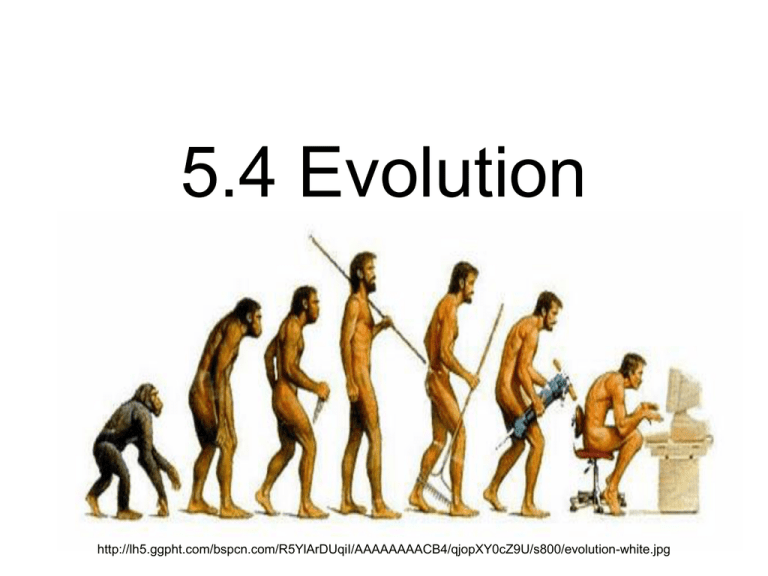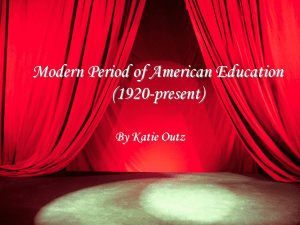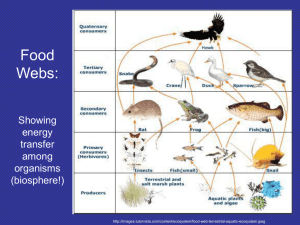
5.4 Evolution
http://lh5.ggpht.com/bspcn.com/R5YlArDUqiI/AAAAAAAACB4/qjopXY0cZ9U/s800/evolution-white.jpg
5.4.1 Define Evolution
• Evolution is the cumulative change in the
heritable characteristics of a population
http://www.txtwriter.com/Backgrounders/graphics/evolution/page2b.jpg
• If we accept not only that species can evolve, but also
that new species arise by evolution from pre-existing
ones, then the whole of life can be seen as unified by its
common origins.
http://darwin.nmsu.edu/~molb470/fall2005/projects/pan/images/PhylogeneticTreeOfLife.jpg
How evolution works…..
We have to start with 2 main ideas and look at
their consequences:
• Populations tend to produce more offspring
than an environment can support.
• There is variation in members of a species.
1. Populations tend to produce more offspring
than an environment can support.(5.4.3)
http://www.senescence.info/overpopulation.jpg
We can
remember
this from our
look at
rabbits in
Australia,
and human
population.
http://www.cartoonstock.com/directory/o/over_population_gifts.asp
2. There is variation in members of a species.
(5.4.5)
Just look around you……
But you need to note that:
Variation within our species
is the result of different
selection pressures
operating in different parts
of the world, yet this
variation is not so vast to
justify a construct such as
race having a biological or
scientific basis.
http://news.softpedia.com/images/news2/12-ofthe-DNA-Differs-Amongst-Human-Races-andPopulations-2.jpg
• This leads to a struggle for existence…….(5.4.4)
Who is
struggling
here?
http://www.wildlifeart.org/artImages/large/struggle_for_existence.jpg
Some organisms within the population have
characteristics that make them better at
overcoming these struggles
The prize for
winning is that they
get to pass on more
of their genes (that
gave them those
characteristics) to
the next generation.
5.4.2 Evidence for Evolution
We will look at:
• 1. The fossil record
• 2. Selective breeding
• 3. Homologous structures
• 4. Modern observed examples
There is much more evidence than this but
that comes in Option D!
1. The Fossil Record
http://www.ucmp.berkeley.
edu/fosrec/images/trex2.gi
f
Foot-prints
How
Fossils
Form
http://www.dkimages.com/discover/previews
/815/10067710.JPG
http://drscavanaugh.org/dino/images/print.jpg
http://activity.ntsec.gov.tw/lifeworld/english/content/im
ages/en_evo_c5.jpg
http://faculty.southwest.tn.edu/rburkett/GB%20Pro5.jpg
Changes in
the skull
http://www.cartage.org.lb/en/themes/sciences/Paleontology/FossilsAndFossilisation/Tax
onomy/Taxonomy.htm
Changes in the teeth
Notice how the teeth of
Hyracotherium were small and with
very few ridges. That's the teeth of
an omnivore, an animal that eats a
variety of food. As the "prehorse"
evolved into a grassland creature it
had to eat grass (surprise!) and its
teeth evolved to best handle the
coarse, gritty texture of grass.
Today's modern horse has very
large teeth well adapted to the
heavy chewing required for an
animal living on a diet of grass.
http://www.synapses.co.uk/evolve/horstet.gif
Fore feet
Changes in the feet
Stages in horse evolution showing the
reduction in the number of toes and
foot bones.
(A)Hyracotherium, a primitive early
Eocene horse with four toes in front
and three behind,
(B) Miohippus, an Oligocene three-toed
horse,
(C) Merychippus, a late Miocene form
with reduced lateral toes,
(D) Equus.
Hind feet
Vertebrate Paleontology by Alfred Sherwood Romer published by The
University of Chicago Press, copyright © 1945, 1966 by The University of
Chicago. All rights reserved. This material may be used and shared with the
fair-use provisions of US copyright law, and it may be archived and
redistributed in electronic form, provided that this entire notice, including
copyright information, is carried.
2. Artificial selection or Selective
breeding
• Humans have been breeding from animals that have
desired traits, and culling animals without those traits for
centuries.
http://www.texaslonghorn.us/Betsy%20&%20Thirteen%20Stars.JPG
https://www.msu.edu/course/isb/202/ebertmay/evo_pres/Slide8.JPG
What traits have
been selected for in
each breed?
Some are: gun
dogs / hunters /
sled pullers /
rescuers / guard
dogs / shepherds /
rabbiters / toys.
What traits would
be good for each of
these jobs?
http://www.cupofdog.com/wpcontent/uploads/2008/06/alldogs
-layout-breed-collec.jpg
This has been happening for centuries with Sheep
Some have been
selected for their
meat.
Others have been
selected for their
wool.
(None have been
selected for their
intelligence! )
http://www.heritagesheep.eu/images/sheepmontague-001.jpg
http://agtr.ilri.cgiar.org/Module/module2/images/SomeChinesePigBreeds.gif
Natural Selection (5.4.7)
• If man can change an organisms
characteristics in a few hundred years
surely environment can given millions…..
• Look at the next slide, using your
knowledge of how characteristics are
passed on, which explanation makes the
most sense?
http://www.tparents.org/Li
brary/Unification/Books/Ev
olTheo/EvolTheo-04.gif
Lamarkism…….
…..or……..
Evolution by natural selection
3. Homologous structures – The
pentadactyl limb
http://upload.wikimedia.org/wikipedia/commons/thumb/5/5b/Evolution_pl.png/500px-Evolution_pl.png
The eye
•
All vertebrate
animals have
eyes with the
same structure.
http://upload.wikimedia.org/wikipedia/commons/thumb/b/
b6/Diagram_of_eye_evolution.svg/429pxDiagram_of_eye_evolution.svg.png
4. Modern evidence for Evolution (5.4.8)
Methicillin Resistant Staphylococcus Aureus
http://www.cdc.gov/mrsa/mr
sa_initiative/skin_infection/i
mages/mrsa_skin_moran6.j
pg
• Bacteria has a very short generation time (as little as 20
minutes!)
• Antibiotics interfere with metabolic pathways of bacteria.
http://ilovebacteria.com
/Images/mrsa.jpg
• Changes in sequences of DNA (mutations)
that allow bacteria to create new pathways
and avoid this interference will happen. (it
is playing the numbers game!)
• Mutations that are beneficial and allow the
bacteria to survive a little longer will get
passed on to more offspring.
MRSA is not the only antibiotic resistant
bacteria…………
Continued
http://unreasonablefaith.files.wordpress.com/2008/06/doonsbury-creationist.jpg
The peppered moth
• Find the Moths….
http://booksdofurnisharoom.typepad.com/.a/6
a00df3521f8108833010536fdcf91970b-800wi
http://images.encarta.msn.com/xrefmedia/sharemed/targets/images/
pho/t012/T012789A.jpg
The genetics of the Moth:
• The colour of the moth is caused by 1
gene.
• The gene makes a protein that is a black
pigment. (B)
• One version of the Gene (an allele) does
not make the protein, this makes peppered
moths. This allele is recessive. (b)
• 200 years ago the black gene was very rare as
Dark moths were at a distinct disadvantage due
to their increased vulnerability to bird predation.
• Lichen on trees camouflages the peppered
variety. But Lichen is very pollution sensitive.
•But as trees lost their
lichen and got
blackened by soot in
the industrial revolution
the numbers of Dark
moths increased.
http://naturalpatriot.org/wp-content/uploads/2007/11/industrial_revolution.jpg
• In 1848, the dark
moths comprised
1% of the
population and by
1959 they
represented ~90%
of the population.
So, in 100 years
the frequency of
dark moths
increased by 1000
fold!
• What would you
expect to be
happening now
that we are
cleaning up our
environment?
The maps show a before-after comparison of the
geographic distribution of melanic phenotypes in
peppered moth populations in Britain based on
Kettlewell's 1956 survey (left map) and that conducted 40years later (1996)
http://www.talkorigins.org/faqs/wells/iconob.html
You might want to also look at……..
http://lhs2.lps.org/staff/sputnam/Biology/U6Evolution/finches.png






